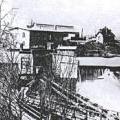 Three components make up the explosive combination of black powder: saltpeter (potassium nitrate), sulphur, and charcoal (carbon). In its heyday, black powder had two primary applications: blasting powder for use in mining operations, and gunpowder for hunting. In 1864, three American entrepreneurs, Thomas Sheldon, Seth Andrews, and Jarvis Marble, decided they would profit from the mining boom that was happening in the Eastern Townships. They established a powder mill in Windsor, on the banks of the Watopeka River, calling it "Sheldon, Andrews, & Company" Over the next half-century, the mill would change hands, and expand in size, several times.
Three components make up the explosive combination of black powder: saltpeter (potassium nitrate), sulphur, and charcoal (carbon). In its heyday, black powder had two primary applications: blasting powder for use in mining operations, and gunpowder for hunting. In 1864, three American entrepreneurs, Thomas Sheldon, Seth Andrews, and Jarvis Marble, decided they would profit from the mining boom that was happening in the Eastern Townships. They established a powder mill in Windsor, on the banks of the Watopeka River, calling it "Sheldon, Andrews, & Company" Over the next half-century, the mill would change hands, and expand in size, several times.
In 1869, with the arrival of a Montreal businessman, George Davies Ferrier, the mill became the "Windsor Powder Company." It manufactured both blasting powder and gunpowder. In 1873, the mill became the first in Canada to manufacture dynamite, a powerful nitroglycerine-based explosive. Purchased by the "Hamilton Powder Company" in 1877, the facility comprised some forty buildings. Bought in 1911 by "Canadian Explosives Ltd.," it underwent a number of modifications to both its product line and equipment. By the end of the First World War, the operation had grown to fifty-six buildings, an enormous complex.
In 1922, a violent explosion rocked the facility, killing a number of workers. This was not the first such accident (since opening, twenty workers had lost their lives on the job). It would, however, be the last. The plant closed its doors that same year.
Seventy years after its closure, the Windsor Powder Mill re-opened with a new vocation - that of an interpretation centre, focusing on the glory days of black powder. The Centre is unique in the country.